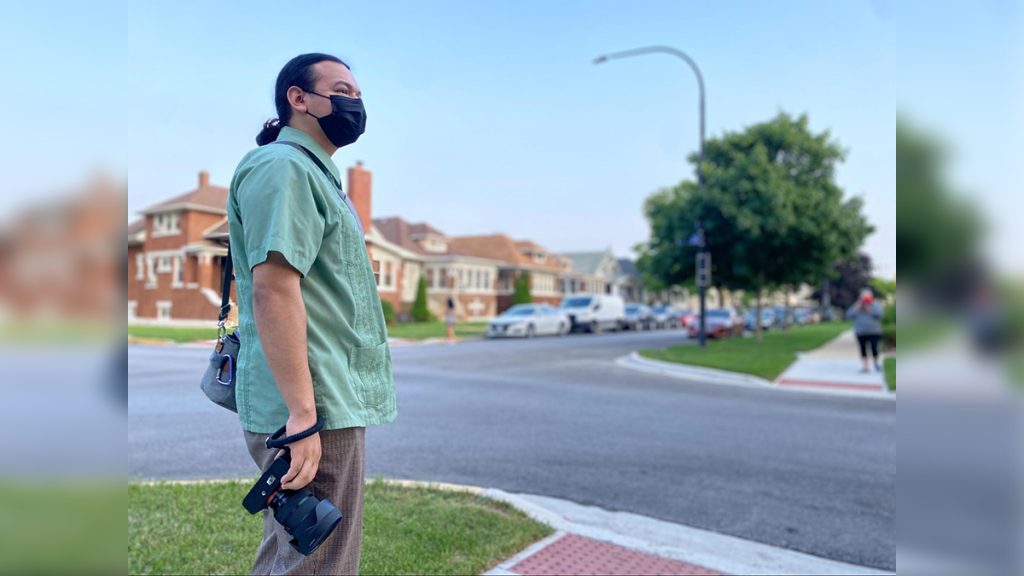
Efrain Soriano makes photos during Cicero Independiente’s photojournalism fellowship Aug. 4, 2022, in Cicero, Ill. Photo: April Alonso | Cicero Independiente
How to onboard a freelance photojournalist
Utilize this onboarding template for photojournalists
Streamlining the onboarding process leads to fewer follow-up emails, phone calls and mistakes. We suggest one onboarding document outlining expectations, workflow and links to useful resources. This will set freelancers up for success, ensuring they have the information they need to make the strongest images.
Reach out to freelancers
We understand deadlines are tight. The earlier you get started on visuals for a story, the better. First, reach out to one photographer and see if they are available for the assignment. If you aren’t sure where to find them, check out our article on freelancer databases.
Let them know if the assignment has a set time (i.e., photographing the source at an event) or if it’s flexible (i.e. making a portrait of them at their home sometime after work.) Let them know the address so they can consider transportation. Set expectations for the next steps, i.e. “We need this photographed next week. If I don’t hear back by tomorrow, I will ask someone else.” If you haven’t already, provide them with an intake form to fill out.
Contract and assignment details
Once a photographer has agreed to take on an assignment, provide them with a contract and assignment details. (Our next RJI article will cover contracts, which are essential for defining the working relationships between newsrooms and photojournalists.)
For the assignment details, provide:
- The who, what, where, when and why
- Share an outline or a draft of the story
- Contact information of the source
- Contact info for the reporter writing the story
- Newsroom contact to call with questions/issues
This helps the photojournalist form a connection with the source and understand useful story context that will inform the style and content of the images.
For example, if it’s a story about bankruptcy, you don’t want an upbeat, high-key (bright) image.
Captions
Caption expectations should be laid out prior to the assignment. Ask photographers to confirm basic details with sources including but not limited to the spelling of their names, their ages and relevant background information.
Captions should be concise and written in present tense, spanning at least two sentences:
- The first sentence details the who, what, where and when of the image and should include the city, state, country (when appropriate) and date.
- The second (and possibly third) sentence should provide contextual information and/or a source quote to help readers understand what they see in the image.
Identify all people in the image, unless large groups make it cumbersome to do so. When identifying multiple people, use directionals (left to right). For unusual spellings, write (CQ) following the name to indicate correct spelling.
For example
From left, film director Resita Cox (CQ) and production coordinator Alexis Bell begin production on the documentary Basketball Heaven on Jan. 11, 2024, in Kinston, N.C. Basketball Heaven showcases a Southern Black community’s resilience, exploring how communal bonds and mentors shape local athletes. The film highlights the importance of healing and community love in the survival and success of Black people. Photo by Donnie Seals Jr.
Photographers should embed the captions in the images and/or on a Google Doc provided by the newsroom. If you prefer captions in a Google Doc where you have the story, that’s fine, but be sure you have ownership of the document so that you don’t have to continually ask for access if the permissions are not accurately set.
To optimize search functions, we also recommend that photographers and editors embed obvious keywords that would be used to search for the photos. By embed, we mean including the details in the file information for the image. Please see our article on how to build a search-optimized digital library for visuals for more details on how to do this.
Delivery
Let the visual journalist know approximately how many images to deliver and what format. Should they be a mixture of vertical and landscape or just landscape? (Landscape is often preferred for the web.) Would you like the captions embedded in the file or in a Google Doc? Would you like full-resolution images, which are needed for print, or are web-sized images (72 DPI) sufficient? Do you have a preference for how the images are delivered, like through Google Drive or Dropbox? And lastly, what is the deadline for delivery?
Payment
Let them know where to send their invoice and W9. Do they need to create a profile on a payroll platform? How will you confirm the amount of payment (i.e., will it be via the contract or written correspondence)? When can they expect payment? Lastly, do you cover expenses such as mileage?
Ethics
If your outlet has a code of ethics it’s important to include that as a resource in the onboarding document.
The National Association of Press Photographers has a code of ethics, and the Authority Collective has a great resource on documenting protests. At a baseline, you should write out that you expect them to make the images themselves, that there be no image manipulation or use of AI and that they obtain informed consent from those photographed.
Cite this article
Kanaar, Michelle; and Schukar, Alyssa (2024, Oct. 1). How to onboard a freelance photojournalist. Reynolds Journalism Institute. Retrieved from: https://rjionline.org/news/how-to-onboard-a-freelance-photojournalist/
